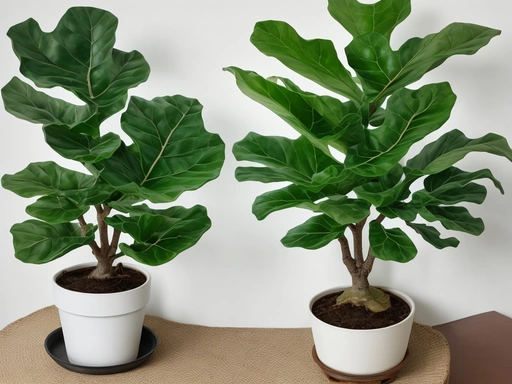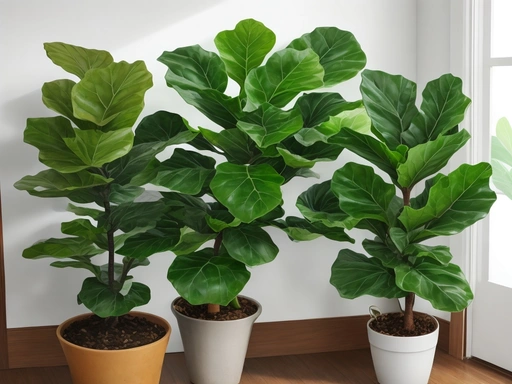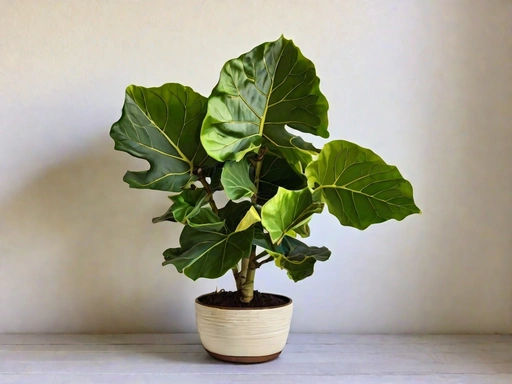Common Misconceptions About Fiddle-Leaf Figs: Busted!
Key Takeaways:
- Fiddle-leaf figs need bright, indirect sunlight to thrive.
- Over-watering is a common mistake that can harm fiddle-leaf figs.
- Fiddle-leaf figs are not low-maintenance plants and require regular care.
- Repotting fiddle-leaf figs too frequently can cause stress to the plant.
Do you own a fiddle-leaf fig or are thinking about getting one? Well, let me tell you, these trendy houseplants have been surrounded by a lot of misconceptions.
From their care requirements to their ability to survive in different conditions, there are many myths floating around.
In this article, we’ll debunk those misconceptions and provide you with the real facts about fiddle-leaf figs. So, whether you’re a beginner or an experienced plant parent, keep reading to discover the truth behind these beautiful and stylish plants.
| Misconception | Explanation |
|---|---|
| Fiddle-leaf figs are easy to care for | While fiddle-leaf figs are known for their aesthetic appeal, they can be quite challenging to care for. They require specific temperature, humidity, and light conditions to thrive. |
| Fiddle-leaf figs need a lot of water | Overwatering is one of the most common mistakes made with fiddle-leaf figs. They prefer well-draining soil and need to dry out between waterings to prevent root rot. |
| Fiddle-leaf figs can withstand direct sunlight | Fiddle-leaf figs prefer bright, indirect light rather than direct sunlight. Exposure to intense sunlight can result in leaf burn and damage. |
| Fiddle-leaf figs need to be repotted frequently | While fiddle-leaf figs can eventually outgrow their pots, they generally do not need to be repotted frequently. Repotting should only be done when necessary or to refresh the soil. |
| Fiddle-leaf figs are safe for pets | Fiddle-leaf figs are toxic to pets if ingested. It’s important to keep them out of reach of curious animals to prevent any potential harm. |
What are Fiddle-leaf figs?
Fiddle-leaf figs are a popular indoor plant known for their large, glossy leaves and tropical appearance.
Overview of Fiddle-leaf figs
Fiddle-leaf figs, also known as Ficus lyrata, are popular houseplants known for their large, glossy leaves.
They are native to the rainforests of West Africa and have become trendy due to their striking appearance.
Fiddle-leaf figs can grow up to 10 feet tall and require bright, indirect light and consistent watering.
With proper care, these plants can add a touch of elegance to any indoor space.

Characteristics of Fiddle-leaf figs
Fiddle-leaf figs are known for their large, glossy, violin-shaped leaves. They have a tropical appearance and can grow up to 10 feet tall indoors.
They prefer bright, indirect light and moderate humidity.
Fiddle-leaf figs are a popular choice for interior decoration due to their attractive foliage. They require regular watering and well-draining soil to thrive.

How to care for Fiddle-leaf figs
To care for your Fiddle-leaf figs, you’ll need to choose the right location, provide proper soil and pot, water and humidify correctly, ensure adequate sunlight and temperature, fertilize and prune as needed, and watch out for common pests and diseases.
Choosing the right location for your Fiddle-leaf fig
To choose the right location for your Fiddle-leaf fig, look for a spot with bright, indirect sunlight. Avoid placing it in direct sunlight as it can scorch the leaves.
Make sure the room has good airflow, but keep it away from drafty areas.
Fiddle-leaf figs prefer stable temperatures, so avoid putting them near windows or vents. Finally, find a spot where you can easily access the plant for watering, pruning, and maintenance.

Proper soil and pot selection for Fiddle-leaf figs
Proper soil and pot selection are important for the health of your Fiddle-leaf fig. Use a well-draining potting mix that allows water to flow through easily.
Avoid heavy soils that hold onto moisture.
Choose a pot with drainage holes to prevent waterlogging. Opt for a pot that is slightly larger than the current root ball, allowing room for growth.

Watering and humidity requirements
Water your Fiddle-leaf fig when the top inch of soil feels dry. Be careful not to overwater as it can lead to root rot.
Maintain moderate humidity levels by misting the leaves or placing a tray with water nearby.
Avoid placing it near drafty areas or heaters as it can cause dryness.
Sunlight and temperature needs
Fiddle-leaf figs thrive in bright, indirect sunlight.
They prefer a spot near a window with filtered light.
Avoid placing them in direct sunlight, as it can scorch their leaves.
As for temperature, they are happiest in a range of 60-75°F (15-24°C).
Avoid exposing them to extreme cold or hot drafts.
Fertilizing and pruning tips
Fertilize your Fiddle-leaf fig monthly during the growing season using a balanced houseplant fertilizer.
Prune your plant to encourage a bushier shape and remove any dead or yellowing leaves.
If you want to control the size, trim the root ball when repotting.
Common pests and diseases to watch out for
Some common pests to watch out for on your Fiddle-leaf fig are mealybugs, spider mites, and scale insects.
These critters can suck the sap from your plant and cause damage.
Disease-wise, root rot and fungal infections can occur if you overwater your fig or if there is poor drainage.
Keep an eye out for any signs of infestation or disease and take action promptly.
Frequently Asked Questions about Fiddle-leaf figs
Can Fiddle-leaf figs survive in low light conditions?
Yes, Fiddle-leaf figs can survive in low light conditions, but they may not thrive.
They prefer bright, indirect light, so if the light is too low, they may become leggy and have fewer leaves.
Consider placing them near a north-facing window or using grow lights to supplement the lack of natural light.
How often should I water my Fiddle-leaf fig?
Fiddle-leaf figs prefer to be watered when the top inch of soil is dry. This usually translates to watering every 1-2 weeks, but it can vary depending on factors like humidity and sunlight.
Check the soil moisture before watering and adjust accordingly.
Can I propagate my Fiddle-leaf fig?
Yes, absolutely! You can propagate your Fiddle-leaf fig.
It’s a fun and rewarding way to create new plants.
The most common method is through stem cuttings.
Simply take a healthy cutting from the top of the plant, allow it to dry out for a couple of days, then place it in water or well-draining soil.
With proper care, your new Fiddle-leaf fig should start growing roots and become a thriving plant.
What are some common problems faced by Fiddle-leaf fig owners?
Fiddle-leaf fig owners commonly face problems such as leaf drop, brown spots, and root rot. These issues can be caused by overwatering, underwatering, poor drainage, low humidity, or pests.
It’s important to find a watering and care routine that works for your specific plant and to keep an eye out for any signs of trouble.
How can I prevent leaf drop on my Fiddle-leaf fig?
To prevent leaf drop on your Fiddle-leaf fig, make sure to provide the right conditions.
Place it in a bright spot with indirect sunlight.
Water it thoroughly but let the top inch of soil dry out before watering again.
Avoid overwatering or letting it sit in standing water.
Keep the humidity levels up by misting the leaves or using a humidifier.
Lastly, avoid moving it around too much as it can stress the plant and lead to leaf drop.
Final Verdict
Fiddle-leaf figs are beautiful and popular houseplants that require specific care to thrive. Contrary to common misconceptions, they are not low-maintenance plants.
They need bright, indirect light, well-draining soil, regular watering, and regular fertilizing.
Proper pruning and monitoring for pests and diseases are also essential. By following these care tips, you can enjoy a healthy and vibrant Fiddle-leaf fig in your home.
Don’t be discouraged by the challenges; with the right knowledge and care, you can create a stunning indoor oasis with your Fiddle-leaf fig.






